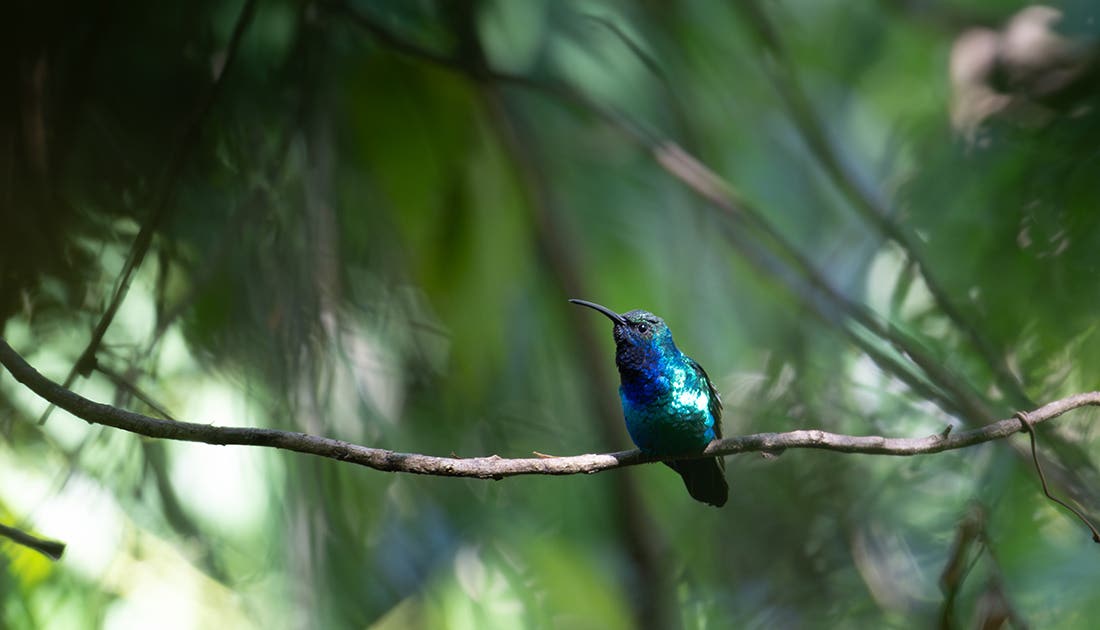There is a distinctive arc the bird commits to when it sings. A swooping dive toward the forest floor, a seconds-long display that might just set him apart. The other males keep him company but he does his best to outshine them. His iridescent blue-green feathers reflect the sun in the right light. Surely this flurry of motion will catch the pair of small, dark eyes, in the undergrowth.
The story of the Santa Marta Sabrewing is only beginning to be told, at least to those outside of its territory in the Sierra Nevada de Santa Marta in northern Colombia. The Indigenous group whose land it shares space with—not mentioned here out of requests for privacy — because of the way it appears after long absences, like a ghost.
“We don’t really understand this species,” says Esteban Botero-Delgadillo, director of conservation science for SELVA: Research for Conservation in the Neotropics, a Colombian NGO. “What we do know is that the Sierra Nevada de Santa Marta is the most important continental center of endemism in the world and most of its species are threatened with extinction. The Santa Marta Sabrewing, as far as we know, is the most threatened bird species of all those endemics and the one we know the least [about].”
Cracking open a mystery
It's an understatement to say the bird has been elusive to science. Until 2022, there had only been one other documented sighting this century, a single bird photographed in 2010. Before that the only specimens known to science were collected in 1872 and 1946, by English explorer Friederick A. A. Simmons and American ornithologist Melbourne Armstrong Carriker from near the Guatapurí River in the Cesar region of Colombia. The Santa Marta Sabrewing was one of the top 10 most wanted lost birds by the Search for Lost Birds, a collaboration between Re:wild, American Bird Conservancy and BirdLife International. It was the first species on the list to be rediscovered.
The ghostly bird was rediscovered in June 2022 by Yurgen Vega, a local birder working with SELVA, ProCAT Colombia and World Parrot Trust, who spotted it by chance while searching for another endemic bird species. Seven months later, a separate group of researchers, Carlos Esteban Lara and Andrés M. Cuervo with Universidad Nacioanle de Colombia, also found four of the birds in the same location.
American Bird Conservancy and the Search for Lost Birds provided a grant to help Vega, SELVA, Universidad Nacional de Colombia learn more about the sabrewing over the past year in partnership with communities in Sierra Nevada de Santa Marta. Returning with a team to the same spot every month since, Vega has seen the bird each time.
“I’ve been lucky enough to go to the field every month and spend four or five days searching for males and females,” says Vega. “I’ve learned a lot: seeing the males lekking and displaying, and the males and females searching for food.”
Botero-Delgadillo is also part of SELVA’s team and says the Santa Marta Sabrewing’s behaviour is similar to the lekking behaviours — a lek is a small area where male birds gather for courtship and mating — of other sabrewings. What sets the species apart, he says, is its ability to survive in habitats with a mix of agroforestry, like coffee and banana plantations, riparian forests and second-growth forest.
“Jurgen took the first-ever pictures of the female and he saw them consuming nectar from banana flowers and gathering material for a nest,” says Botero-Delgadillo. “In terms of migration, it has been suggested that the hummingbirds move between two different regions: the paramo and the forest below. If that happens to be true, their ecological role would be more important than we have thought they would move nutrients, genes, and energy between ecosystems. They might have a different ecological function compared to the other endemics.”
Going back to the source
Five months after SELVA’s rediscovery of the Santa Marta Sabrewing, a team of scientists, led by Andrés Cuervo, from the Universidad Nacional de Colombia (UNAL) found the bird in a different location in the Sierra Nevada de Santa Marta, but this sighting wasn’t by chance.
“We mapped Simmons and Carriker’s original expedition and then we headed up to the mountains and just followed their path,” says Carlos Esteban Lara, assistant professor of Ecology at UNAL. “The first morning out there we saw the bird. We just could not believe it.”
Like the SELVA team, Lara and his colleagues have returned to the area every month since and the sabrewing has been there every time.
“We were so excited but completely quiet with our microphones, trying to get the first-ever sound recordings of this elusive species,” says Lara. “One of our colleagues is a good photographer and we had time to also gather some amazing pictures and videos of this species.”
Collaboration and conservation
Now, SELVA, ProCAT and the UNAL, with help from American Bird Conservancy, are sharing their research to better understand the Santa Marta Sabrewing. Their findings were posted on bioRxiv in March 2024. Both Botero-Delgadillo and Lara are curious about the bird’s range and whether or not it does indeed migrate, given the fact that the birds found in both of the locations stay there year-round.
“Simmons, the explorer who first collected this bird, has many observations of this hummingbird as high as 4,000 meters up in the mountains,” says Lara. “We don't know if what we are seeing here is the tail of the distribution and it's more abundant up in the mountains, and so maybe it moves all-year round, but we are almost certain that the species has a very narrow distribution across the Sierra Nevada de Santa Marta.”
Learning more hinges on participation and collaboration with the local and Indigenous community. Some of Lara’s students at the UNAL are from the community, and have been critical members of the research team, helping to obtain permission and consent to enter the Santa Marta Sabrewing’s habitat and study it.
SELVA has also forged connections with the group, in the hopes of partnering with communities to determine how best to protect the species.
“You first need to understand what you want to protect or conserve,” says Botero-Delgadillo. “If we manage to understand what this species is doing and how important it is from an ecological point of view, maybe that will reveal other threats or aspects that we haven't seen yet that are really important to the conservation of the whole region, the whole ecosystem.”
The fact the Santa Marta Sabrewing is surviving amongst the community’s coffee and banana farms indicates to Lara that the community’s land use works for the hummingbird.
“Definitely, we have to explore more, but it seems the way they’re using the land is not a threat for the species,” he says.
What other messages the species may have to share at this point are unknown; but both research teams and the community are listening.
The Search for Lost Birds is supported by Allbirds.
Katie Doke Sawatzky is a journalist originating from and living on the dwindling Canadian Prairie, in Treaty 4 territory and the homeland of the Métis. Her multimedia project prairiecommons.ca examined the state of native prairie in Saskatchewan, its biodiversity, and its public and spiritual value. She is based in Regina.




